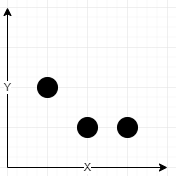You are given an array of network towers towers and an integer radius,
where towers[i] = [xi, yi, qi] denotes the
ith network tower with location (xi,
yi) and quality factor qi. All the
coordinates are integral coordinates on the X-Y plane, and the distance
between two coordinates is the Euclidean distance.
The integer radius denotes the maximum distance in
which the tower is reachable. The tower is
reachable if the distance is less than or equal to
radius. Outside that distance, the signal becomes garbled, and the
tower is not reachable.
The signal quality of the ith tower at a coordinate (x,
y) is calculated with the formula ⌊qi / (1 + d)⌋,
where d is the distance between the tower and the coordinate. The
network quality at a coordinate is the sum of the signal qualities
from all the reachable towers.
Return the integral coordinate where the network quality is maximum. If there are multiple coordinates with the same network quality, return the lexicographically minimum coordinate.
Note:
- A coordinate
(x1, y1)is lexicographically smaller than(x2, y2)if eitherx1 < x2orx1 == x2andy1 < y2. ⌊val⌋is the greatest integer less than or equal toval(the floor function).
Example 1:

Input: towers = [[1,2,5],[2,1,7],[3,1,9]], radius = 2 Output: [2,1] Explanation: At coordinate (2, 1) the total quality is 13 - Quality of 7 from (2, 1) results in ⌊7 / (1 + sqrt(0)⌋ = ⌊7⌋ = 7 - Quality of 5 from (1, 2) results in ⌊5 / (1 + sqrt(2)⌋ = ⌊2.07⌋ = 2 - Quality of 9 from (3, 1) results in ⌊9 / (1 + sqrt(1)⌋ = ⌊4.5⌋ = 4 No other coordinate has higher quality.
Example 2:
Input: towers = [[23,11,21]], radius = 9 Output: [23,11]
Example 3:
Input: towers = [[1,2,13],[2,1,7],[0,1,9]], radius = 2 Output: [1,2]
Example 4:
Input: towers = [[2,1,9],[0,1,9]], radius = 2 Output: [0,1] Explanation: Both (0, 1) and (2, 1) are optimal in terms of quality but (0, 1) is lexicograpically minimal.
Constraints:
1 <= towers.length <= 50towers[i].length == 30 <= xi, yi, qi <= 501 <= radius <= 50